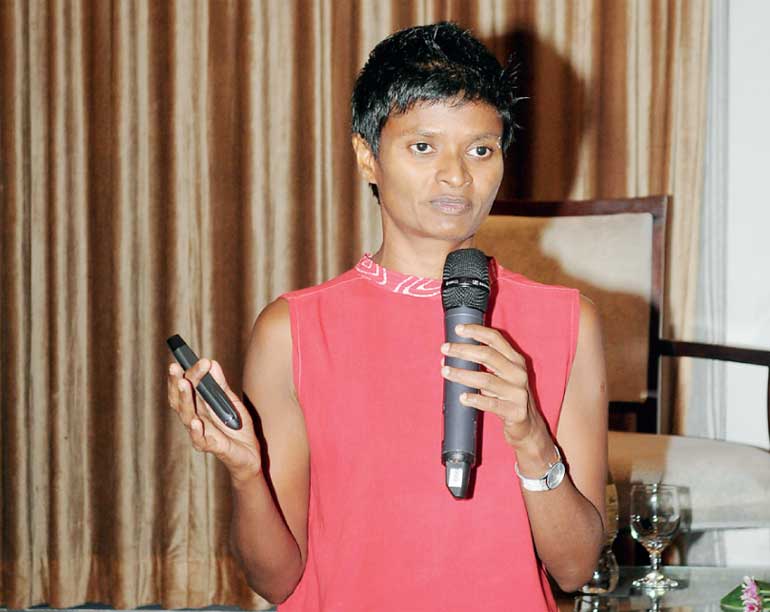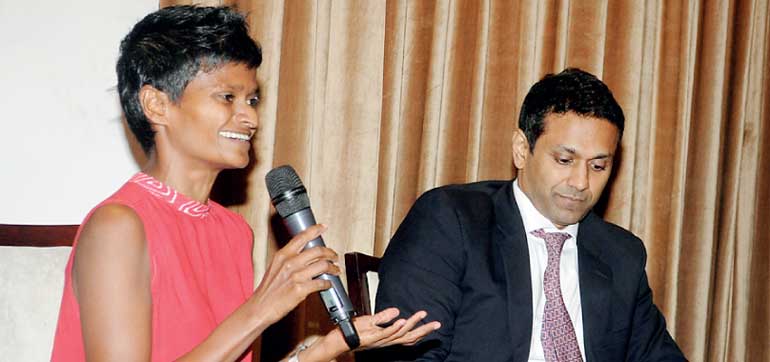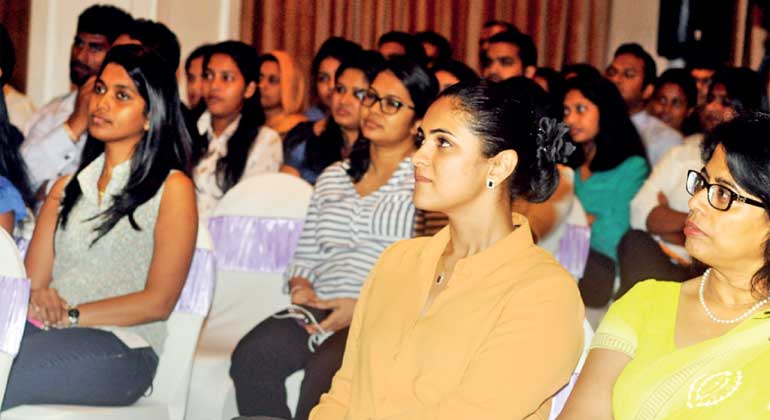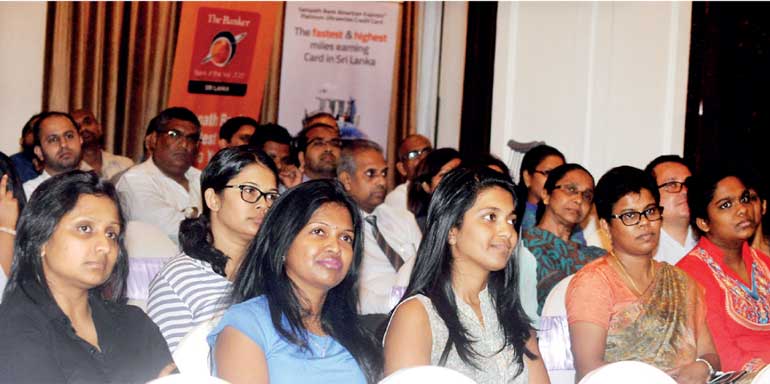Wednesday Feb 26, 2025
Wednesday Feb 26, 2025
Tuesday, 20 September 2016 00:01 - - {{hitsCtrl.values.hits}}
 Jayanthi Kuru-Utumpala sharing her experience of the Mount Everest Expedition during an event organised by Women in Logistic and Transport (WILAT) at The Kingsbury in Colombo recently
Jayanthi Kuru-Utumpala sharing her experience of the Mount Everest Expedition during an event organised by Women in Logistic and Transport (WILAT) at The Kingsbury in Colombo recently
By Shannine Daniel
21 May was indeed a memorable day for us Sri Lankans; it was on this day at 5:20 a.m. that Jayanthi Kuru-Utumpala became the first Sri Lankan to summit Mount Everest. Amidst all odds she has become not only the first Lankan but also the first Asian to scale up to the very top of the great mountain.
A lover of adventure sports with a passion for mountain climbing in particular, Jayanthi is a strong activist for women’s rights and being in the spotlight as the first Sri Lankan to climb Mount Everest has indeed given her a much louder voice in her fight to bring an end to gender stereotypes and the gender-based prejudice that women face on a daily basis.
Before regaling the audience with her experiences on the mountain, Jayanthi stated that from a young age she had secretly dreamt of one day climbing the heights of Mount Everest but was afraid to speak of it sensing that she would be discouraged from pursuing it. However that did not stop her from engaging in extreme sports, particularly rock climbing; at the age 23 she then took up mountaineering course which allowed her to learn the necessary skills needed for both rock climbing and ice climbing such as avoiding altitude sickness.
Jayanthi went on to say that in order to prepare themselves for the Everest expedition, she and Johann first scaled Island Peak, Nepal in 2012 and Mount Kilimanjaro in 2014, aside from Sri Lanka’s own mountains, such as Adam’s Peak. Aside from these expeditions Jayanthi and Johann engaged in other activities to strengthen their bodies, such as interval training while climbing mountains, swimming and other forms of exercise.
“Many people wonder how we did it, because both Johann and I have full-time jobs that demand our time. The only free time we had was before and after work so we really had to put our minds into it and work hard. The past two years were so consumed by preparations for the expedition that I had to give up socialising, because this was more important to me,” she stated.
Part of their preparation also included drawing up a list of the necessary equipment and other items that were vital for their expedition.
“This was a challenge itself since it took us two whole years to finalise this list; once we got home after work, we sat down at our computers, did our online research and then wrote down the things we needed. We also wanted to make sure we got the best quality equipment; this was a life or death situation and relying on low quality equipment was a huge risk we wanted to avoid,” she stressed.
“To make matters a little more difficult none of the equipment we needed was available in Sri Lanka, since we have no icy mountains in our landscape. Fortunately I was able to travel to New York for a few days at the beginning of the year and Johann also joined me so we were able to purchase some of the equipment there, but we had to purchase the remaining items online.”

The cost per person for the expedition amounted to about Rs. 10 million and Jayanthi stated that getting sponsorships was no easy feat; many people the two of them approached to get sponsorships from had no faith that they would able to fulfil their goal.
“Since it was not cricket or rugger, people didn’t understand what we were trying to do,” she recalled.
Later on the duo received support from sponsors and crowd-funded part of their expenses. They picked the well-reputed International Mountain Guides as their guiding company, which would provide them with the necessary accommodation, food and Sherpa guides for the two-month-long expedition.
“We wanted to go with the correct company, which would ensure that we got to the top and overall we were quite happy with them. So many climbers have endangered their lives by settling for cheaper companies which provide low quality services and inexperienced guides,” she said, once again pointing out that it was a matter of life or death on the mountain and even the smallest mistake could prove fatal.

Moving on to talk about the expedition itself, Jayanthi highlighted an important piece of information – why the expedition went on for two months.
“There are four camps located on Mount Everest and before we climb the peak of Mount Everest we had to complete three acclimatisation rounds, from base camp to camp two and back again, base camp to camp three and back again and finally base camp to camp four and back again. Except for camp four, we were allowed to rest for a few days at each camp.”
It was only after these three gruelling acclimatisation rounds, a harrowing journey made more so by a large area of ice between base camp and camp two known as the ‘Khumbu Ice fall’, that the team was given the green light by their guides to summit the mountain. This was one of the most testing challenges of the journey and really taught Jayanthi, Johann and the rest of their team (they were part of an international climbing team) the importance of both physical and mental strength and endurance.
Another tough challenge she had to face was keeping with the necessary timing between camps which meant that she had to maintain a certain speed in order to remain in the expedition.
“Because I was much smaller than the rest, the others had an advantage over me and were able to cover a lot more ground than I did. I had to put in a lot of effort to keep up.”
Speaking about the living conditions during the journey, Jayanthi revealed that out of the four camps, the base camp had the best food and proper sanitation. However, unfortunately the remaining three camps did not offer such good facilities and the team really had to rough it out with open toilets and rather tasteless food at a high altitude with sub-zero temperatures.
“We had to really adjust to that environment for those two months. It was challenging but we managed to work it all out once we put our minds into it. Johann has a very positive outlook and he always kept encouraging me,” she fondly said of her friend and teammate.
Jayanthi revealed that she also faced a great deal of negative reactions from certain people when training and preparing for the expedition along with her friend and team mate Johann Peiris.

Jayanthi shared her story at a motivational programme organised by Women in Transport and Logistics (WILAT) Sri Lanka. She commended the members of WILAT for being active in a male-dominated sector of the economy.
“When I think of transport and logistics, I always think of men working with huge containers and ships, because most of us don’t expect women to work in such a sector. We each have our own Mount Everest to climb and I realised that some of the things that Johann and I learned through this expedition, such as a positive mindset and being determined to achieve specific goals, can also be applied in the corporate sector as well,” she stated.
In conclusion Jayanthi stated that she wanted to go forward with her work in fighting for women’s rights and breaking the gender stereotypes in Sri Lankan society. She also encouraged everyone look at life’s hardships with a positive attitude and focus on achieving one’s goals with passion and determination.
Discover Kapruka, the leading online shopping platform in Sri Lanka, where you can conveniently send Gifts and Flowers to your loved ones for any event including Valentine ’s Day. Explore a wide range of popular Shopping Categories on Kapruka, including Toys, Groceries, Electronics, Birthday Cakes, Fruits, Chocolates, Flower Bouquets, Clothing, Watches, Lingerie, Gift Sets and Jewellery. Also if you’re interested in selling with Kapruka, Partner Central by Kapruka is the best solution to start with. Moreover, through Kapruka Global Shop, you can also enjoy the convenience of purchasing products from renowned platforms like Amazon and eBay and have them delivered to Sri Lanka.
Discover Kapruka, the leading online shopping platform in Sri Lanka, where you can conveniently send Gifts and Flowers to your loved ones for any event including Valentine ’s Day. Explore a wide range of popular Shopping Categories on Kapruka, including Toys, Groceries, Electronics, Birthday Cakes, Fruits, Chocolates, Flower Bouquets, Clothing, Watches, Lingerie, Gift Sets and Jewellery. Also if you’re interested in selling with Kapruka, Partner Central by Kapruka is the best solution to start with. Moreover, through Kapruka Global Shop, you can also enjoy the convenience of purchasing products from renowned platforms like Amazon and eBay and have them delivered to Sri Lanka.